Source:https://stlgreeks.wordpress.com/2019/02/02/st-louis-greeks-and-their-fight-for-macedonia/
 Too much praise cannot be given the volunteers from America who rushed to the aid of the kingdom. They gave up their business, maybe their futures, and some of them their lives, and others their health and strength. Those who fell will be honored by their nation as long as time lasts.
Too much praise cannot be given the volunteers from America who rushed to the aid of the kingdom. They gave up their business, maybe their futures, and some of them their lives, and others their health and strength. Those who fell will be honored by their nation as long as time lasts.
These words of Colonel Thomas Hutchison, an American retired officer who served as a volunteer in the Balkan Wars and in 1913 produced a best-selling account of his time in Greece, frame today, almost a century after their original composition, a literary cenotaph for the thousands of Greek immigrants to America who returned home to fight for a Greek Macedonia during the Balkan Wars (1912-1913).

National histories have completely omitted their efforts and even when, in those rare occasions, the unsung story receives a laconic entry in the general histories of Hellenism in America (as in the following quote by Charles Moskos, who epigrammatically notes that “inspired by patriotic feelings about Greece and their traditional hatred of Ottoman Turkey, more than 45,000 Greek-American immigrants returned to Greece to fight in the Balkan Wars of 1912–1913”), still the paradox of historical void becomes even more pronounced for, if the numbers hold true, then more than one/fourth of the Greek army was constituted by those transnational Greek soldiers who bravely fought in Epirus and Macedonia.
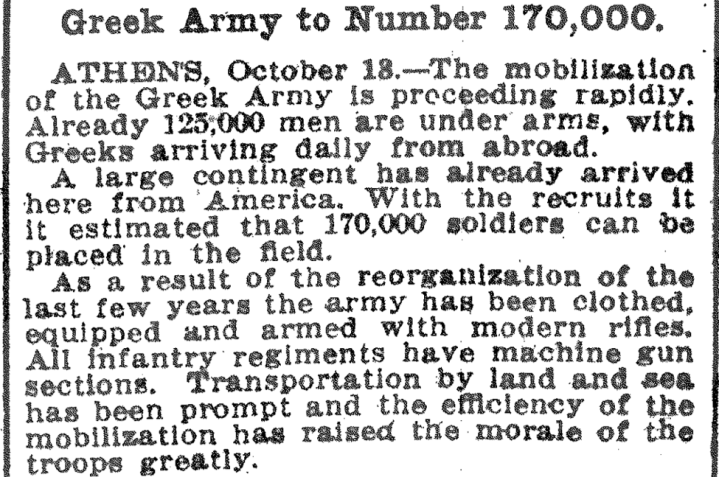
There is an abundance of sources that confirms the contribution of St. Louis Greeks to the struggle for Macedonia. St. Louis back in the early 20th century started experiencing a continuous influx of Greek immigrants that peaked during and after the World Fair in 1904.

The establishment of the first Orthodox Greek church in the city in 1906 (the Church of the Holy Trinity on 19th and Morgan) became the epicenter of the Greek community.

Soon after, starting in 1907, various ethnotopika somateia, that is, mutual help associations uniting immigrants from the same village or region, constituted the most powerful hubs of social life and group identity for the Greeks in the city. Of the three active such Greek associations in St. Louis in 1909, two of them, the Macedonian Society “National Defense” and the “Brotherhood of Sopiki”, were transnationally attached to lands in Macedonia and Northern Epirus respectively. The third association, the “Panhellenic Union”, was a large national organization that tried to mobilize Greek immigrants in the United States. It was founded initially in 1907 as a federation of the Greek societies and communities in the United States and eventually evolved as the major organization for the preparation of the Greeks in America to go and fight on the Macedonian front. Thanks to Seraphim Canoutas, who published a list of the places with branches of the Panhellenic Union in 1909, we know that St. Louis was one of the first cities to have established and operate an office under the directorship of Panagiotis Apostolos.
By the early 1900’s, a great number of ethnically Greek immigrants from the still Ottoman Macedonia arrived in St. Louis. Official Greek documents, that were previously thought lost, with important information about thousands of Greeks from Ottoman Macedonia who left the area between 1900-1910 and immigrated to the States, have become now available to researchers. Among those documents there are catalogues with lists of names of hundreds of Greeks from Macedonia who arrived to St. Louis during that time (we should devote a separate study to such an important archival source).

This influx of Macedonian Greeks to the city during the first decade of 1900 was one of the primary reasons for the establishment of a second Greek community in St. Louis. City records show that in 1910 a new Greek Orthodox community was formed, alongside the older parish of the Holy Trinity at 19th and Morgan. The Church of Evangelismos (The Annunciation), conducted its first services at 17th and Olive. Dr. Mandelares, Nick Kerhoulas, Achilles Papaconstantinou and Menas Coucoulis were the first Church officers and it’s not perhaps without historical significance that the new Church’s inception coincides chronologically with the preparations among Greeks in the city for the ensuing war. Even more noteworthy is the fact that the Church of Evangelismos dissolved in 1913 since most of its parishioners returned to Greece to fight in the Balkan Wars
On October 9, 1910, the St Louis Post-Dispatch publishes a long article on this “Strange new colony” which had formed now a militia unit with American uniforms of 115 men and was contacting its military drills and training in the basement of the Greek Church while waiting orders to attack Turkey.
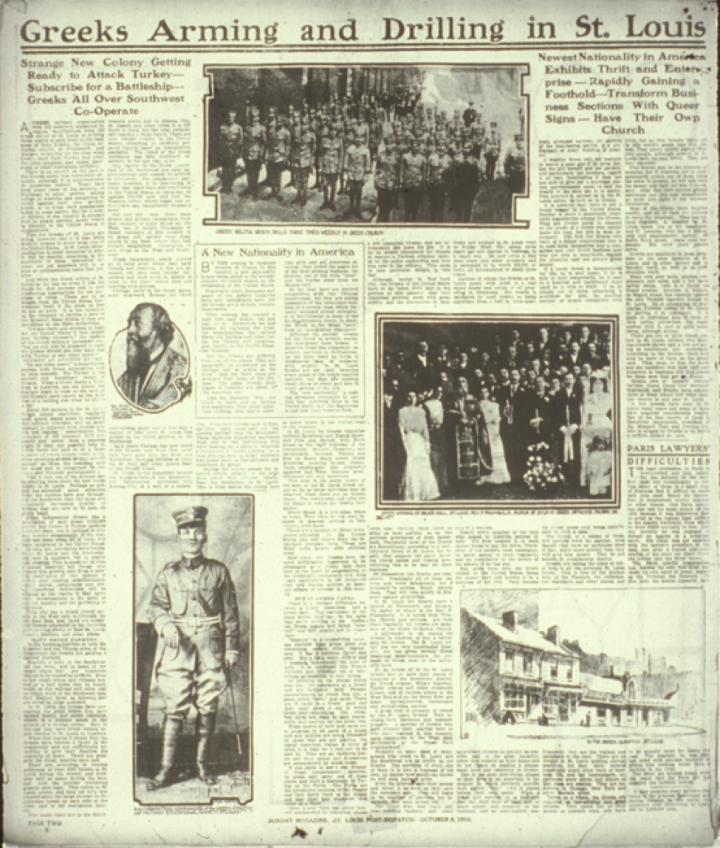
Although the author of the article initially thinks unconstitutional the use of American soil as the training base of a foreign military unit, he soon enthusiastically recants when he is informed that the unit is in direct negotiations with the American government to buy rifles for its members and it is awaiting final confirmation to become part of the Missouri State Millitia. As the leader of the unit, Sergeant Antonios Carapates explains: “We are ready and anxious to fight for the United States if that should ever become necessary,” quickly adding however, “but we will also be prepared to fight for Greece should she ever have war with Turkey”!
By the late summer of 1912, signs of an imminent war with Turkey became clear and in early October the Greeks in St. Louis anxiously prepared to go and fight for Macedonia. On October 6, more than 2000 Greeks were gathered in Druid’s Hall on 9th and Market, to hear the Greek consul Hector Pesmazoglou, the parish priest father Phiambolis and other community leaders about the needs of the hour.
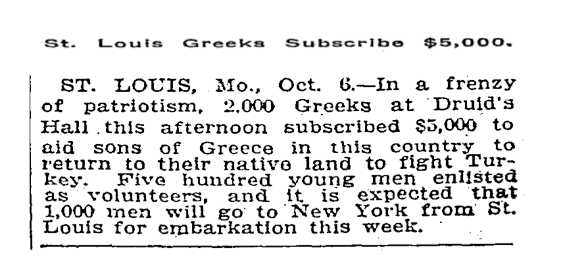
The Greek consul presented a Greek and an American flag to the more than 800 volunteers that were departing the following days.

The months of October and November of 1912 were to become memorable moments in Greek-American history. Members of volunteer units massed together in their respective communities, paraded down the streets of their cities, listened to patriotic orators, and departed to defend their country. On October 26, 1912, the Greek Consul was once again the main instigator in rallying his fellow countrymen. As the war was now raging in the Balkans, some 5,000 Greeks gathered outside the Church of the Holy Trinity to hear Hector Pesmazoglou and attend a special mass by father Phiambolis.

A military company of 700 men from St. Louis, Kansas City, Denver and SF was led by Dr. John Soteropoulos, an officer of the Greek army and a member of the Greek Red Cross.
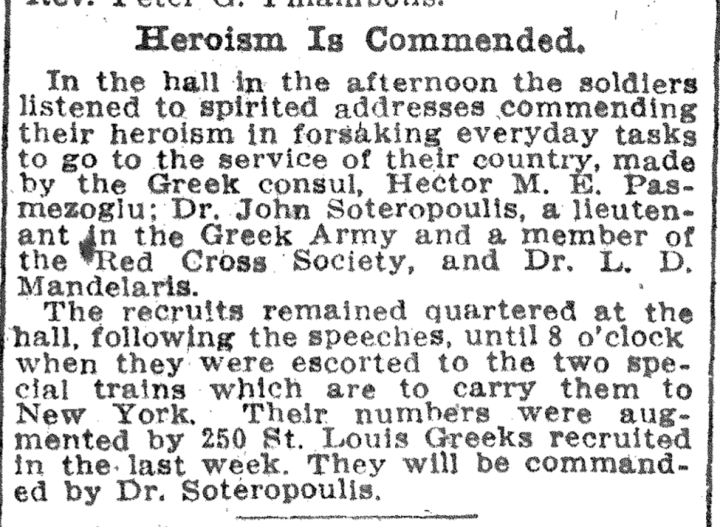
The enthusiastic Greek crowd, then, followed the marching company through the streets of St. Louis to the Union station where they boarded on two special trains for New York.
The exact number of Greeks who left St Louis to go back to Greece to fight is almost impossible to calculate with any accuracy but they should have been roughly between 1000-1500 men. It is equally impossible to recount what happened to them once they arrived to Greece: How many actually fought, where and how, what is the number of casualties and how many were wounded? The only indirect information we have is that several of them fought alongside General Garibaldi’s red-shirt brigades at Bizanie, near the city of Ioannina.

In a letter that was published in the St Louis Globe-Democrat, on December 17, 1912, Dr. John Soteropoulos who left St. Louis commanding more than 200 men, reports from Bizanie to his fellow Greeks, and tells them of the heroism of those mortally wounded who begged him to keep them alive long enough to walk the liberated streets of Ioannina and then happily die. Sotiropoulos also mentions Christ Pappas, a shoe maker, who had been injured in a battle on the island of Chios and then again seriously wounded in Bizanie. John Kiros and Stavros Pavlakis, both candy makers, were privates in an infantry regiment under the command of Crown Prince Constantine, Soteropoulos continues, and they had been already in a lot of engagements. Finally, the restaurateur James Karadimas, refused to leave the front when he was deemed unable to qualify for active service, and was permitted to follow the regiment in which many men from St. Louis were enlisted, according to Soteropoulos.
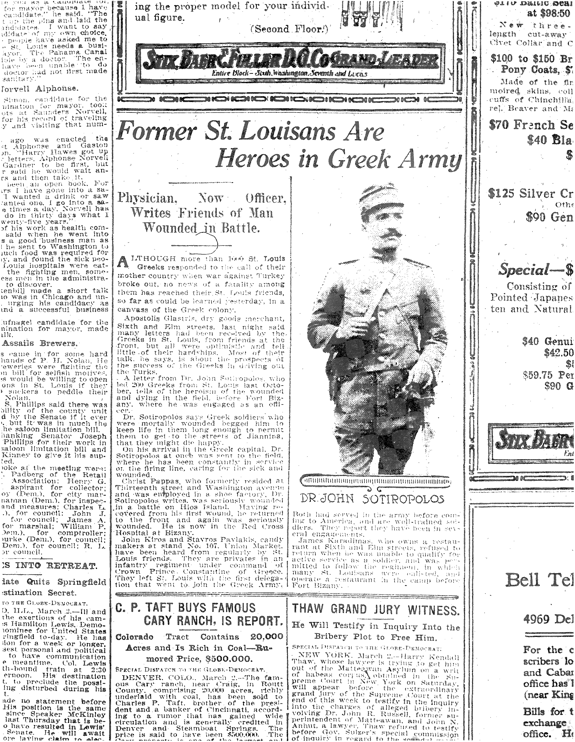
In 1915, two years after the end of the Balkan Wars, King Constantine of Greece was quoted in an interview with the Associated Press as saying that most of the 45,000 who came to Greece as volunteers, returned to the United States:
But this time the emigration has been with a major difference. At first… the men went alone. Their idea was to make a modest fortune, return to their families in Greece, buy a little farm or a shop in one of the cities and live in comfort to the end of their days among their own people. But a good many of those who returned to America after … they had served their country nobly in the Balkan Wars, took their families with them on the second trip. For them, it was no longer an experiment fraught with the risks and dangers of unknown adventure. They had been to America once. They had learned where and how to live. So when they sailed for the West the second time, it was with all their belongings, not so much in the spirit of the ancient Greeks, going into the world in search of fortune and adventure as had been the habit of Greeks for thirty-five centuries, but rather as prospective Americans, almost all of them quitting their mother country forever.
The Balkan wars may have rallied immigrants as transnational fighters on behalf of Greece, but the determination to re-emigrate at the conclusion of the fighting also underlined the immigrants’ nascent rooting in America. The fight for Macedonia allowed St. Louis Greeks to prove their unquestionable love for their motherland, but also became the terminus post quem of their new Greek-American ethnicity.
Σχόλια
Δημοσίευση σχολίου
Ο σχολιασμός του αναγνώστη (ενημερωμένου η μη) είναι το καύσιμο για το ιστολόγιο αυτό, έτσι σας προτρέπουμε να μας πείτε την γνώμη σας. Τα σχόλια οφείλουν να είναι κόσμια, εντός θέματος και γραμμένα με Ελληνικούς χαρακτήρες (όχι greeklish και κεφαλαία).
Καλό είναι όποιος θέλει να διατηρεί την ανωνυμία του να χρησιμοποιεί ένα ψευδώνυμο έτσι ώστε σε περίπτωση διαλόγου, να γίνεται αντιληπτό ποιος είπε τι. Κάθε σχόλιο το οποίο είναι υβριστικό η εμπαθές, θα διαγράφεται αυτομάτως.